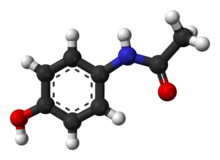ᱯᱟᱨᱟᱥᱤᱴᱟᱢᱳᱞ
Paraceta, also known as acetaminophen, is a medication used to treat pain and fever.[᱑᱒][᱑᱓] It is typically used for mild to moderate pain relief.[᱑᱒] Evidence is mixed for its use to relieve fever in children.[᱑᱔][᱑᱕] It is often sold in combination with other medications, such as in many cold medications.[᱑᱒] Paracetamol is also used for severe pain, such as cancer pain and pain after surgery, in combination with opioid pain medication.[᱑᱖] It is typically used either by mouth or rectally, but is also available by injection into a vein.[᱑᱒][᱑᱗] Effects last between two and four hours.[᱑᱗]
Paracetamol is generally safe at recommended doses.[᱑᱘][᱑᱙] The recommended maximum daily dose for an adult is three to four grams.[᱒᱐][᱒᱑][᱑᱙] Higher doses may lead to toxicity, including liver failure.[᱑᱒] Serious skin rashes may rarely occur.[᱑᱒] It appears to be safe during pregnancy and when breastfeeding.[᱑᱒] In those with liver disease, it may still be used, but in lower doses.[᱒᱒] It is classified as a mild analgesic.[᱑᱗] It does not have significant anti-inflammatory activity.[᱒᱓] How it works is not entirely clear.[᱒᱓][᱒᱔][᱒᱕]
Paracetamol was first made in 1877.[᱒᱖] It is the most commonly used medication for pain and fever in both the United States and Europe.[᱒᱗] It is on the World Health Organization's List of Essential Medicines.[᱒᱘] Paracetamol is available as a generic medication, with brand names including Tylenol and Panadol among others.[᱒᱙] In 2017, it was the 25th-most commonly prescribed medication in the United States, with more than 24 million prescriptions.[᱓᱐][᱓᱑] ᱪᱷᱟᱸᱪ:TOC limit
- ↑ ᱑.᱐ ᱑.᱑ "Acetaminophen Use During Pregnancy". Drugs.com. 14 ᱡᱩᱱ 2019. Archived from the original on 9 ᱢᱟᱨᱪ 2020. Retrieved 25 ᱯᱷᱮᱵᱽᱨᱩᱣᱟᱨᱤ 2020.
- ↑ ᱛᱩᱢᱟᱹᱞ ᱦᱩᱲᱟᱹᱜ:Invalid
<ref>tag; no text was provided for refs nameddrugs.com-internatl - ↑ ᱓.᱐ ᱓.᱑ "Codapane Forte Paracetamol and codeine phosphate product information" (PDF). TGA eBusiness Services. Alphapharm Pty Limited. 29 ᱮᱯᱨᱤᱞ 2013. Archived from the original on 6 ᱯᱷᱮᱵᱽᱨᱩᱣᱟᱨᱤ 2016. Retrieved 10 ᱢᱮ 2014.
- ↑ Working Group of the Australian and New Zealand College of Anaesthetists and Faculty of Pain Medicine (2015). Schug SA, Palmer GM, Scott DA, Halliwell R, Trinca J (eds.). Acute Pain Management: Scientific Evidence (4th ed.). Melbourne: Australian and New Zealand College of Anaesthetists (ANZCA), Faculty of Pain Medicine (FPM). ISBN 978-0-9873236-7-5. Archived from the original (PDF) on 31 ᱡᱩᱞᱟᱭ 2019. Retrieved 28 ᱚᱠᱴᱚᱵᱚᱨ 2019.
- ↑ "Tylenol, Tylenol Infants' Drops (acetaminophen) dosing, indications, interactions, adverse effects, and more". Medscape Reference. Archived from the original on 14 ᱮᱯᱨᱤᱞ 2014. Retrieved 10 ᱢᱮ 2014.
- ↑ "Acetaminophen Pathway (therapeutic doses), Pharmacokinetics". Archived from the original on 4 ᱢᱟᱨᱪ 2016. Retrieved 13 ᱡᱟᱱᱩᱣᱟᱨᱤ 2016.
- ↑ ᱗.᱐ ᱗.᱑ ᱗.᱒ Pickering G, Macian N, Libert F, Cardot JM, Coissard S, Perovitch P, Maury M, Dubray C (ᱥᱮᱯᱴᱮᱢᱵᱚᱨ 2014). "Buccal acetaminophen provides fast analgesia: two randomized clinical trials in healthy volunteers". Drug Des. Devel. Ther. 8: 1621–1627. doi:10.2147/DDDT.S63476. PMC 4189711. PMID 25302017.
bAPAP has a faster time of antinociception onset (15 minutes, P<0.01) and greater antinociception at 50 minutes (P<0.01, CT1) and 30 minutes (P<0.01, CT2) than ivAPAP and sAPAP. All routes are similar after 50 minutes. ... In postoperative conditions for acute pain of mild to moderate intensity, the quickest reported time to onset of analgesia with APAP is 8 minutes9 for the iv route and 37 minutes6 for the oral route.
- ↑ Wong A, Graudins A (2017). "Risk prediction of hepatotoxicity in paracetamol poisoning". Clin Toxicol (Phila). 55 (8): 879–892. doi:10.1080/15563650.2017.1317349. PMID 28447858. S2CID 8888616.
{{cite journal}}: CS1 maint: uses authors parameter (link) - ↑ ᱙.᱐ ᱙.᱑ ᱙.᱒ ᱙.᱓ ᱙.᱔ Granberg RA, Rasmuson AC (1999). "Solubility of paracetamol in pure solvents". Journal of Chemical & Engineering Data. 44 (6): 1391–95. doi:10.1021/je990124v.
- ↑ Karthikeyan M, Glen RC, Bender A (2005). "General Melting Point Prediction Based on a Diverse Compound Data Set and Artificial Neural Networks". Journal of Chemical Information and Modeling. 45 (3): 581–590. doi:10.1021/ci0500132. PMID 15921448.
- ↑ "melting point data for paracetamol". Lxsrv7.oru.edu. Archived from the original on 30 ᱡᱩᱱ 2012. Retrieved 19 ᱢᱟᱨᱪ 2011.
- ↑ ᱑᱒.᱐ ᱑᱒.᱑ ᱑᱒.᱒ ᱑᱒.᱓ ᱑᱒.᱔ ᱑᱒.᱕ ᱑᱒.᱖ "Acetaminophen". The American Society of Health-System Pharmacists. Archived from the original on 5 ᱡᱩᱱ 2016. Retrieved 16 ᱥᱮᱯᱴᱮᱢᱵᱚᱨ 2016.
- ↑ Lee, WM (ᱰᱤᱥᱮᱢᱵᱚᱨ 2017). "Acetaminophen (APAP) hepatotoxicity-Isn't it time for APAP to go away?". Journal of Hepatology. 67 (6): 1324–1331. doi:10.1016/j.jhep.2017.07.005. PMC 5696016. PMID 28734939.
- ↑ Meremikwu M, Oyo-Ita A (2002). "Paracetamol for treating fever in children". The Cochrane Database of Systematic Reviews (2): CD003676. doi:10.1002/14651858.CD003676. PMC 6532671. PMID 12076499.
- ↑ de Martino M, Chiarugi A (2015). "Recent Advances in Pediatric Use of Oral Paracetamol in Fever and Pain Management". Pain and Therapy. 4 (2): 149–168. doi:10.1007/s40122-015-0040-z. PMC 4676765. PMID 26518691.
- ↑ Scottish Intercollegiate Guidelines Network (SIGN) (2008). "6.1 and 7.1.1" (PDF). Guideline 106: Control of pain in adults with cancer. Scotland: National Health Service (NHS). ISBN 9781905813384. Archived (PDF) from the original on 20 ᱰᱤᱥᱮᱢᱵᱚᱨ 2010.
- ↑ ᱑᱗.᱐ ᱑᱗.᱑ ᱑᱗.᱒ Hochhauser, Daniel (2014). Cancer and its Management. John Wiley & Sons. p. 119. ISBN 9781118468715. Archived from the original on 8 ᱥᱮᱯᱴᱮᱢᱵᱚᱨ 2017.
{{cite book}}: Unknown parameter|name-list-format=ignored (help) - ↑ Russell FM, Shann F, Curtis N, Mulholland K (2003). "Evidence on the use of paracetamol in febrile children". Bulletin of the World Health Organization. 81 (5): 367–72. hdl:10665/268935. ISSN 0042-9686. PMC 2572451. PMID 12856055.
- ↑ ᱑᱙.᱐ ᱑᱙.᱑ ᱛᱩᱢᱟᱹᱞ ᱦᱩᱲᱟᱹᱜ:Invalid
<ref>tag; no text was provided for refs namedBMJ2015 - ↑ "Paracetamol for adults: painkiller to treat aches, pains and fever". National Health Service. Archived from the original on 22 ᱚᱜᱚᱥᱴ 2017. Retrieved 22 ᱚᱜᱚᱥᱴ 2017.
- ↑ "What are the recommended maximum daily dosages of acetaminophen in adults and children?". Medscape. Archived from the original on 21 ᱰᱤᱥᱮᱢᱵᱚᱨ 2018. Retrieved 19 ᱰᱤᱥᱮᱢᱵᱚᱨ 2018.
- ↑ Lewis JH, Stine JG (ᱡᱩᱱ 2013). "Review article: prescribing medications in patients with cirrhosis - a practical guide". Alimentary Pharmacology & Therapeutics. 37 (12): 1132–56. doi:10.1111/apt.12324. PMID 23638982. S2CID 20759947.
- ↑ ᱒᱓.᱐ ᱒᱓.᱑ McKay, Gerard A.; Walters, Matthew R. (2013). "Non-Opioid Analgesics". Lecture Notes Clinical Pharmacology and Therapeutics (9th ed.). Hoboken: Wiley. ISBN 9781118344897. Archived from the original on 8 ᱥᱮᱯᱴᱮᱢᱵᱚᱨ 2017. Retrieved 7 ᱥᱮᱯᱴᱮᱢᱵᱚᱨ 2017.
{{cite book}}: Unknown parameter|name-list-format=ignored (help) - ↑ ᱛᱩᱢᱟᱹᱞ ᱦᱩᱲᱟᱹᱜ:Invalid
<ref>tag; no text was provided for refs namedGhanem2016 - ↑ ᱛᱩᱢᱟᱹᱞ ᱦᱩᱲᱟᱹᱜ:Invalid
<ref>tag; no text was provided for refs namedpmid18381460 - ↑ Mangus, Brent C.; Miller, Michael G. (2005). Pharmacology application in athletic training. Philadelphia, Pennsylvania: F.A. Davis. p. 39. ISBN 9780803620278. Archived from the original on 8 ᱥᱮᱯᱴᱮᱢᱵᱚᱨ 2017. Retrieved 7 ᱥᱮᱯᱴᱮᱢᱵᱚᱨ 2017.
{{cite book}}: Unknown parameter|name-list-format=ignored (help) - ↑ Aghababian, Richard V. (22 ᱚᱠᱴᱚᱵᱚᱨ 2010). Essentials of emergency medicine. Jones & Bartlett Publishers. p. 814. ISBN 978-1-4496-1846-9. Archived from the original on 17 ᱚᱜᱚᱥᱴ 2016.
{{cite book}}: Unknown parameter|name-list-format=ignored (help) - ↑ World Health Organization (2019). World Health Organization model list of essential medicines: 21st list 2019. Geneva: World Health Organization. hdl:10665/325771. WHO/MVP/EMP/IAU/2019.06. License: CC BY-NC-SA 3.0 IGO.
- ↑ Hamilton, Richard J. (2013). Tarascon pocket pharmacopoeia : 2013 classic shirt-pocket edition (27th ed.). Burlington, Massachusetts: Jones & Bartlett Learning. p. 12. ISBN 9781449665869. Archived from the original on 8 ᱥᱮᱯᱴᱮᱢᱵᱚᱨ 2017.
{{cite book}}: Unknown parameter|name-list-format=ignored (help) - ↑ "The Top 300 of 2020". ClinCalc. Archived from the original on 18 ᱢᱟᱨᱪ 2020. Retrieved 25 ᱯᱷᱮᱵᱽᱨᱩᱣᱟᱨᱤ 2020.
- ↑ "Acetaminophen Drug Usage Statistics". ClinCalc. Archived from the original on 12 ᱮᱯᱨᱤᱞ 2020. Retrieved 11 ᱮᱯᱨᱤᱞ 2020.
- Articles with short description
- Short description is different from Wikidata
- Use dmy dates from December 2019
- Articles with invalid date parameter in template
- Template:drugs.com link with non-standard subpage
- Drugs with non-standard legal status
- ECHA InfoCard ID from Wikidata
- Pages with incorrect formatting templates use
- Multiple chemicals in Infobox drug
- Multiple chemicals in an infobox that need indexing
- Drugboxes which contain changes to watched fields
- ᱥᱟᱦᱴᱟ ᱨᱮ ᱥᱟᱹᱠᱷᱭᱟᱹᱛ ᱠᱚ ᱵᱷᱩᱞ ᱜᱮ ᱢᱮᱱᱟᱜᱼᱟ
- CS1 maint: uses authors parameter
- CS1 errors: unsupported parameter


